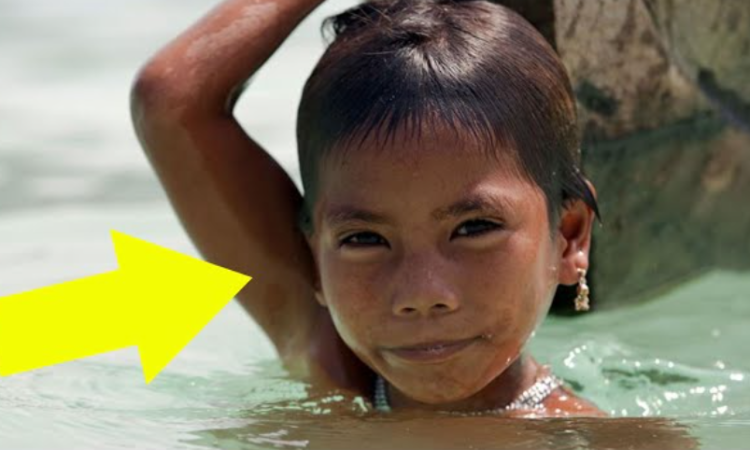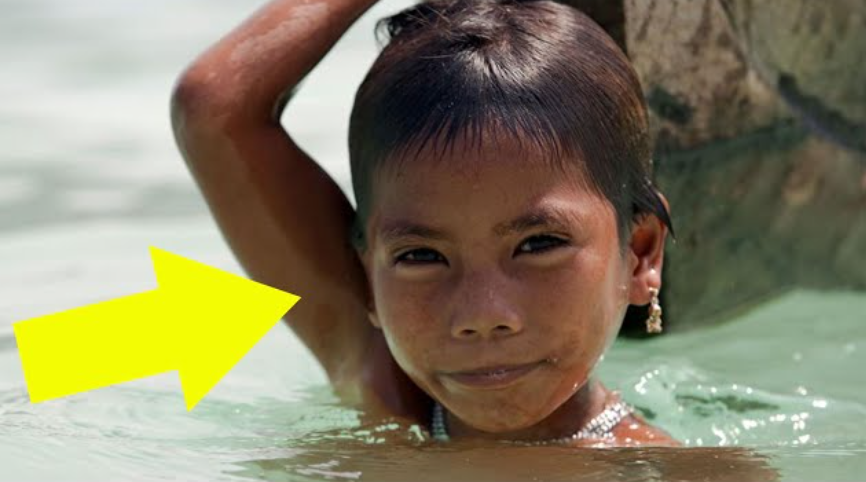This Tribe Spend Most Of Their Lives In The Water, And Their Bodies Have Adapted In A Bizarre Way

“This tribe spends most of their lives in the water, and their bodies have adapted in a bizarre way. Well, you might not have heard of them; the mysterious Bajau laut tribe have hit the headlines recently. These people from Southeast Asia live a truly fascinating lifestyle, devoting around 60% of each day to life under the waves. As a result, their bodies have changed dramatically over the years, with scientists recently uncovering an incredible genetic adaptation.

Sometimes referred to as sea nomads, the Bajau lived in several different areas around Asia, such as the Philippines, Brunei, and Malaysia. In terms of numbers, it’s believed that the tribe is comprised of over 1 million people. And as their nickname suggests, they’re often found out on the water. In fact, the Bajau don’t have houses or a place to call home on the shore. Instead, groups operate off boats that they put together themselves, which are known as leper leper vessels. While out on the water, they scour the seafloor for fish and other items they can sell on land.
With that in mind, some of the Bajau are underwater for more than half their working day. As a result of that, these individuals have to rely on their ability to hold their breath for long periods. Curious about the tribe’s unique lifestyle, a group of researchers took a closer look at their biological makeup, revealing the results in April 2018.
In Western society, many of us are able to live our lives more or less as we see fit, whether that’s settling down or traveling to certain parts of the world. We all have different ideas of exactly what it is that we want to do. Yet for some people, their future lifestyle will be defined for them by previous generations. Tribes such as the Bajau laut are a case in point. The sea nomads have been roaming around Southeast Asia for hundreds of years. In fact, you can find records of this particular tribe that date all the way back to the 16th century.
During that period, a man named Antonio Pigafetta formed part of an ambitious project. A former resident of Venice, Italy, Pigafetta joined the crew of Spanish-sponsored Portuguese explorer Magellan in his 1519 bid to find a new route to India. Some three years later, the journey was finally concluded, but in 1521, the Italian explorer made note of an interesting discovery. That year, Pigafetta came across the Bajau in the ocean.
As for the Bajau’s origins, the stories have continued to vary throughout the years, region to region. However, most of those tales have one thing in common. Indeed, it’s believed that these sea nomads once served an Asian king on the shore, who was the father of a princess. From there, the stories diverged regarding what happened next, but in the end, the princess always went missing. As a result of that, the king subsequently dispatched the original Bajau to bring her back. When they couldn’t find her, though, the group then opted to stay out at sea to avoid her father’s anger.
In terms of the differences, the Bajau laut from Borneo believed that their ancestors worked as guards for a Malaysian royal family. They were tasked to transport their princes to the Filipino province of Sulu, where she would tie the knot with its leader. But there was one major issue. According to that particular story, Vernice Sultan, who wanted to marry the Malaysian princess as well, prompting him to send a fleet to intercept the guards. Due to that attack, they lost their royal charge as a sultan and decided to settle around Borneo.
However, the various tales don’t end there. For instance, the origin story of the Bajau in Indonesia is that a princess got lost at sea during the great flood. Before long, she was retrieved from the water and went on to marry a member of the Gowan royal family. After that, their children allegedly chose the nomadic life in the Indonesian Machado. Meanwhile, some members of the Bajau laut in the Philippines fall back on a more fantastical tale. In their story, there is no princess. Instead, they believe that a giant stingray transported them to a certain area of the Asian country, leading them to the sea area that they inhabit today.
Regardless of their various origin stories, though, the Bajau laut’s lifestyle follows the same patterns. Rather than living on the land, they build homes in the water that are held up by stilts. And in other instances, people from the tribe would sometimes decide that a single boat was enough. As we previously mentioned, the Machado spend a lot of time underwater, where they hunt for food and potential items to trade.
But much like everyone else, their bodies face the same obstacles that we do when we swim deeper below the surface. Obviously, the further down you go, the more pressure you face. However, the Bajau have a solution for that as they burst their eardrums as youngsters. “You bleed from your ears and nose,” Emma and Lajas and told UK newspaper The Guardian in September 2010, “and if you have to spend a week lying down because of the dizziness after that, you can dive without pain.”
In terms of the equipment that the Bajau use, they rely on goggles made from wood with a glass lens. Alongside that, the divers bring a type of spear gun with them as well, crafted from materials such as metal and rubber. But while that doesn’t seem like a lot, they’re able to get around thanks to an incredible ability. Indeed, certain members of the Bajau laut can hold their breath for extended periods underwater, giving them more time to get what they need. In fact, in some cases, it’s believed that these individuals can stay underwater for close to a quarter of an hour.
Unsurprisingly, though, such extreme diving can come at a cost. While the ruptured eardrums have helped the Bajau divers down the years, the pressures of deep-sea swimming have led to some major issues. One of the biggest problems is referred to as the bends, otherwise known as decompression sickness. This particular ailment can have a horrible effect on the body. Bajau who have come to the bends can suffer permanent disabilities or even death. In a few cases, the problem comes about when a person dives to significant depths then swims back to the surface too quickly. By doing that, they don’t give their body a chance to depressurize at a steady and controlled rate.
Sadly, that’s not the only issue that the Bajau have had to face in recent times. Adding to their woes, the Indonesian government has been clamping down on the tribe’s traditional ideals, resulting in some controversial outcomes. Due to those moves, countless members of the group have been coerced into moving onshore. But despite those obstacles, not everyone has suffered the same fate. In fact, many of the Bajau laut have been able to erect their own small communities on the water.
Much like the houses, these towns are held up on stilts, with one such Indonesian settlement taking on the name Torro Sighs. The village itself cuts quite a remarkable sight; it’s located more than half a mile away from the shore. Given its position, though, Torro Sighs can prove somewhat challenging to reach, especially if a person doesn’t have an engine attached to their boat. Residence and Kasim can certainly attest to that. A member of the Bajau, Kasim lives on her lap, Aleppo, for about half a year at a time. Alongside our child Ronda, together they make ends meet with whatever they can find in the water during the day before joining their tribe in the evening.
At that point, they moor their boats near an island shore to eat and relax. Yet while Kasim enjoys those aspects of her life, the journey to the village on stilts is hard for her. “I love being at sea,” she told The Guardian in 2010. “Fishing, rowing, just feeling everything, the cold, the heat. But when I have to go to Torro Sighs, I have to row. We don’t have anything.”
My husband died from decompression sickness roughly five years on from that interview. A scientist named Melissa Alardoe took a trip to Thailand. As it happened, the University of Copenhagen employee found out about the Bajau laut while on her travels from there, an idea struck the geneticist, and she visited the tribe in Indonesia.
Prior to that, a study had been conducted into the role of the spleen when swimming mammals held their breath underwater. At that stage, researchers focused their attention on seals, noting that the organ in question was larger than expected. The reason, it transpired, was that the spleen was able to store oxygen-rich red blood cells. So because they boasted larger spleens, scientists believed that seals could survive without air for longer periods. On that note, Alardoe wanted to see if the Bajau laut were in any way similar, given their ability to hold their breath.
But before revealing what she did, the geneticist touched upon a fascinating point. “There’s a human dive response that’s triggered by holding your breath and submerging yourself in water,” Alardoe told the BBC show “Inside Science” in April 2018. “You can trigger it by submerging your face in cold water.” After that, the scientist explained what happened next, referring back to the spleen’s role.
Alardoe continued, “Your heart rate slows down; you have peripheral vasoconstriction, where the vessels in your extremities get smaller to preserve the oxygenated blood for your vital organs. And then the last thing is a contraction of the spleen. The spleen is a reservoir for oxygenated red blood cells. So when the spleen contracts, it gives you an oxygen boost.” A large Oh added, “It’s like a biological scuba tank.”
With that in mind, she planned to test the Bajau laut when she arrived in Indonesia back in 2015. However, the researcher didn’t want to dive into the work straight away. Instead, Alardoe intended to talk with members of the tribe first, even joining them on some of their hunts. Looking back, she recalled one of those instances to The Atlantic magazine in 2018.
When she followed a man named Pied Leo Boo, while they were out, he caught sight of a clam about 50 feet underwater,” Alardoe told the publication. “But Boo just dropped down; he pointed at the clam, and then he was there underwater. The Bajau are as comfortable as most people are on land. They walk on the sea floor; they have complete control of their breath and body; they spearfish no problem, first try.”
After Alardoe got to know the Bajau, she then came back a little later with an ultrasound device alongside some spit collection kits. In total, 43 members of the tribe were tested. But that’s not all; to draw a comparison, 33 individuals from a nearby community known as the Saloon were also scanned. Unlike the Bajau, the Saloon lived on land in Indonesia, working primarily as farmers.
Once the tests were done, Alardoe and her colleagues went on to look over the results. Incredibly, the sea nomads had spleens that were about 50 percent larger than their shore-dwelling neighbors. However, that didn’t signal the end of the study’s fascinating findings. The researchers discovered a certain gene in the Bajau DNA samples, which hadn’t shown up in the Saloon. The gene in question is known as PDE 10a, and it keeps a particular hormone under control in the thyroid gland. In previous research projects, the PVE 10a gene was found in mice, with experts connecting that to the size of their spleens. Indeed, when the rodents were deprived of it, the organ was much smaller.
After the results were gathered, they were subsequently published in the Cell Science Journal in April 2018. In conclusion, Alardoe believed that Darwinian natural selection had come into play for the Bajau laut, with their biological makeup adapting to their surroundings. Her team couldn’t pinpoint the exact time when this change occurred, but they brought up another intriguing figure. According to them, the tribe split away from the mainland some 15,000 years ago. Alardoe and her colleagues pointed out that such a time frame was a viable period for the adaptation to have happened.
Meanwhile, a co-author of the study raised one final point. Speaking to BBC News, Rasmus Nielsen said, “It’s a wonderful example of how humans can adapt to their local environments. But there may be some medical interest in this.” Neilson added, “There’s been a lot of interest in the understanding of hypoxia adaptations, adaptations to low oxygen levels. If you look at trauma medicine, one of the most important factors is the response to low oxygen levels. By studying the Bajau, we can figure out what are some of the genes that help predict differences in people and how they respond to acute low oxygen levels.”




